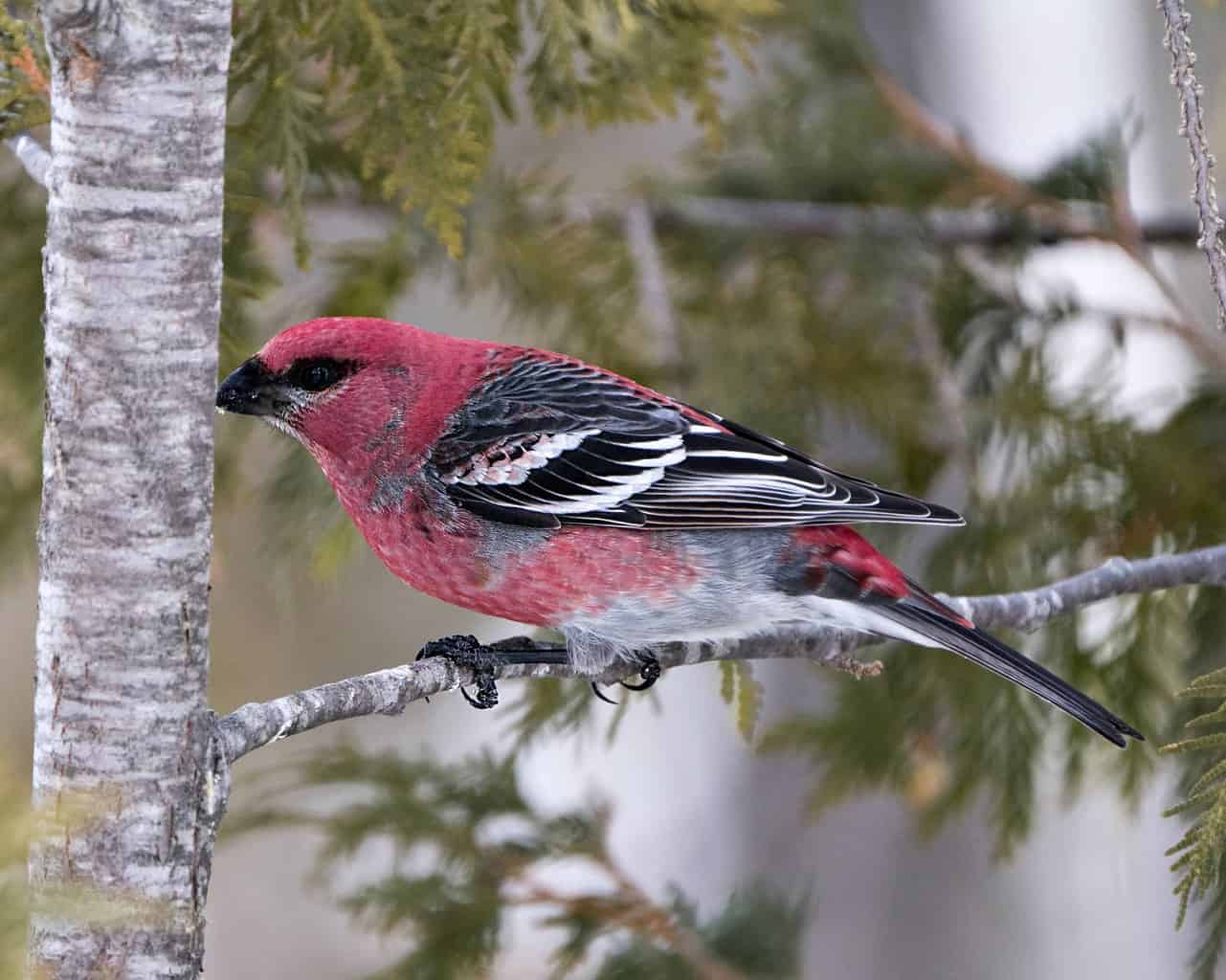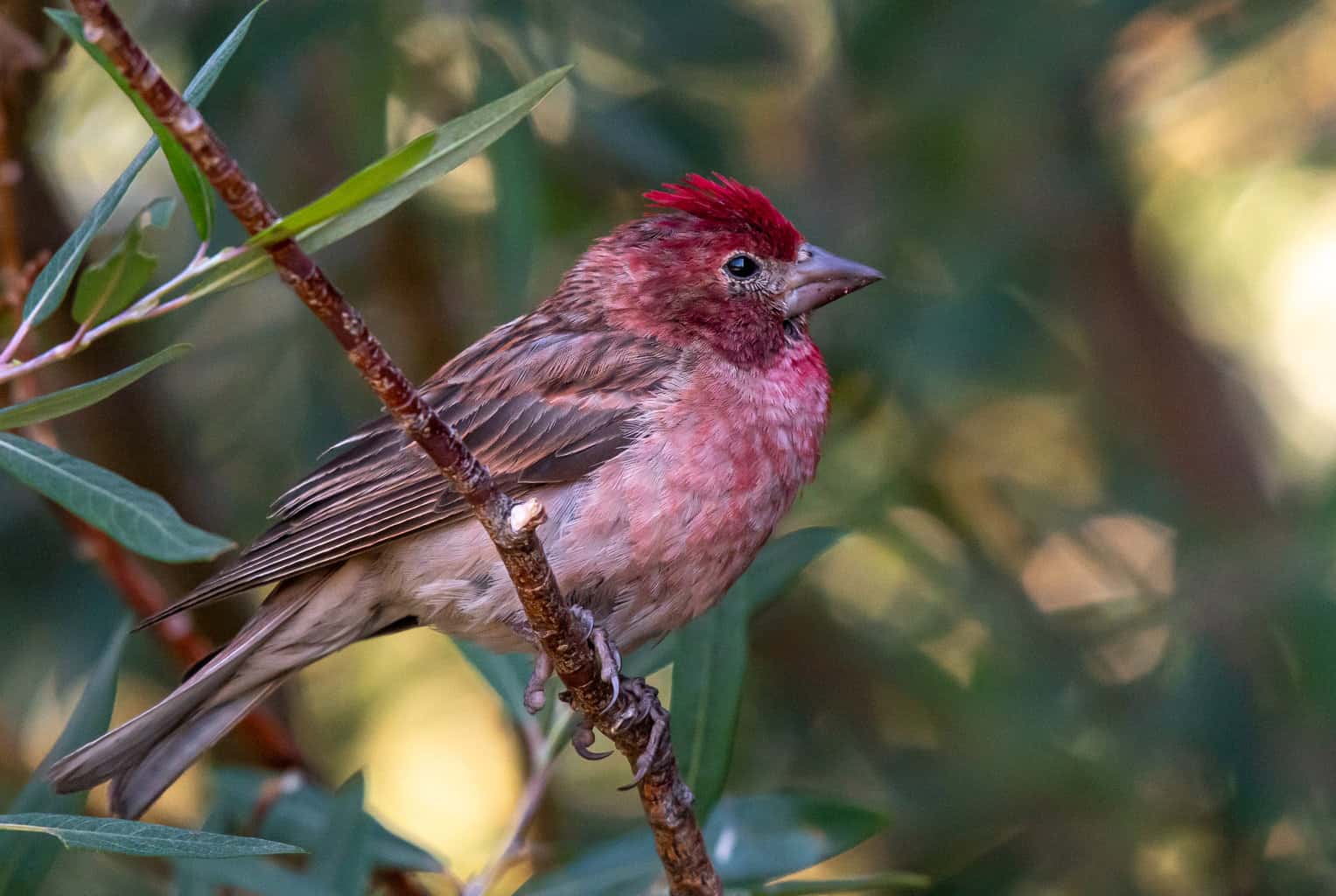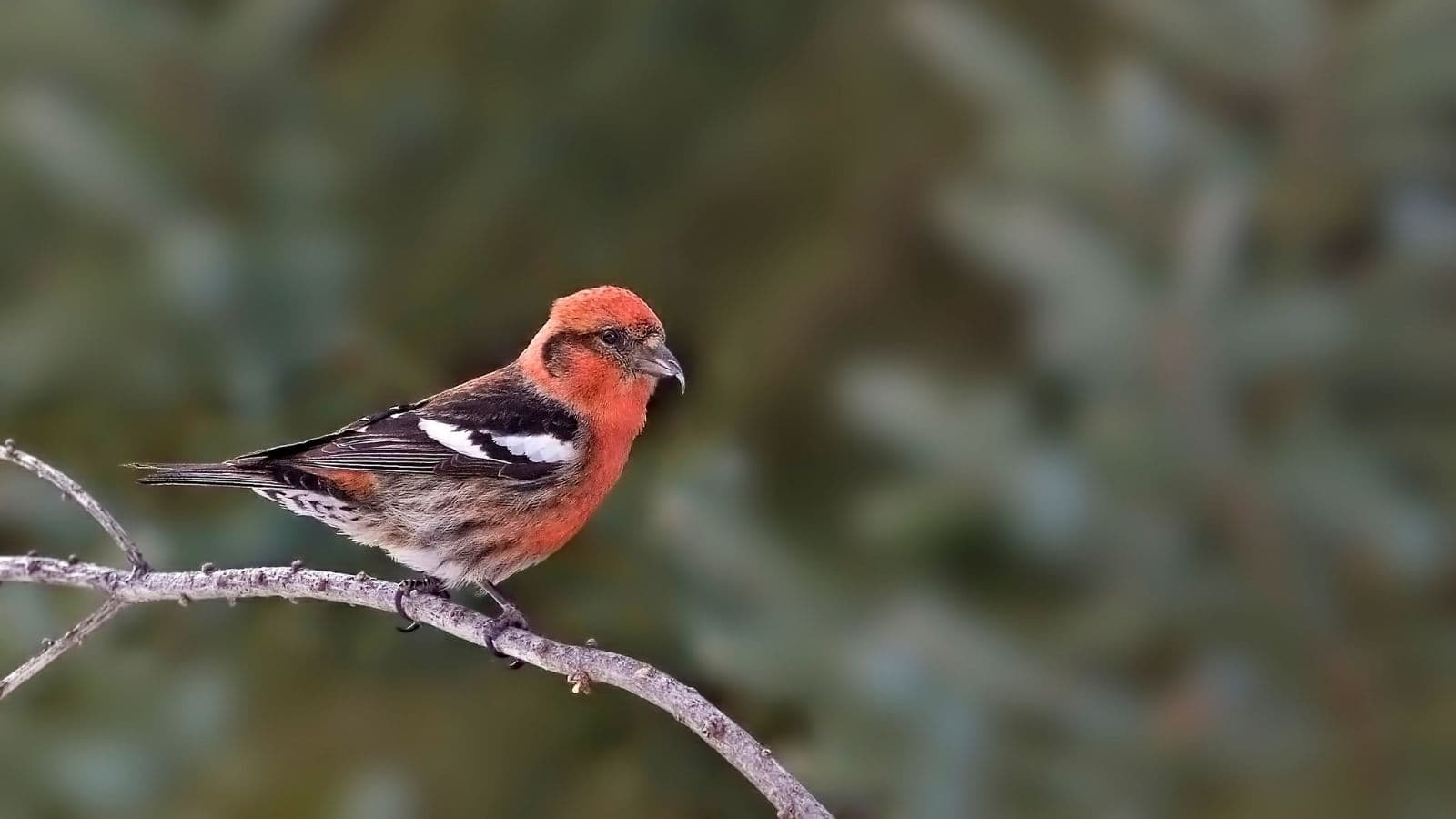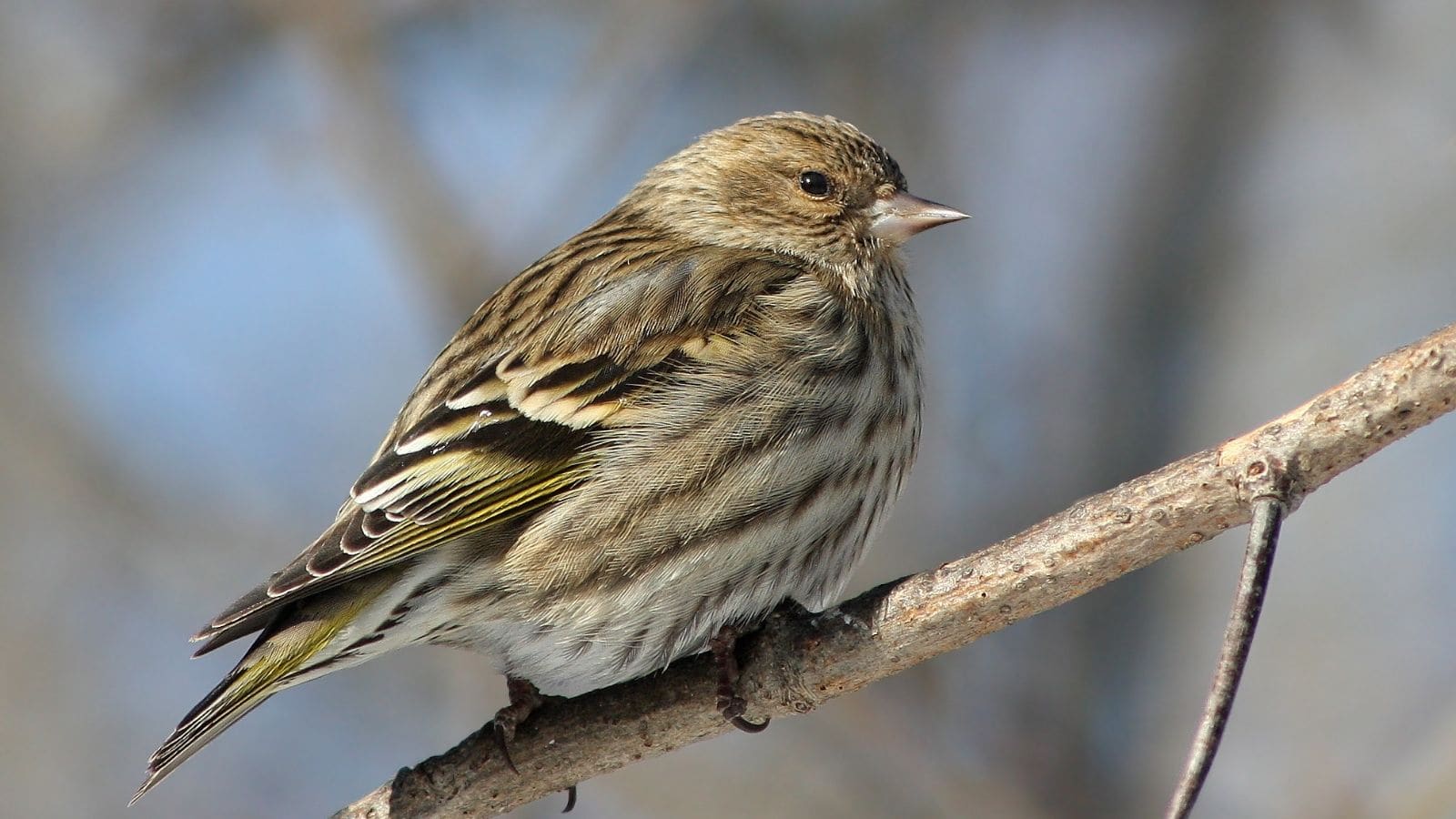Oklahoma’s state bird is the scissor-tailed flycatcher, a pale gray kingbird that alights in Texas’ northern neighbor in spring.
And yet, this passerine, also known for the length of its tail and its impressive ability to put raptors to flight, is just one of 488 bird species in Oklahoma.
Twelve out of that vast selection happen to be finches. Also passerines, they belong to their very own family consisting of over 200 species and are known for being especially adaptable.
This article is dedicated to exploring beautiful finches in Oklahoma. Here you will get to discover what these members of that intriguing vast classification look like, details about their behavior, and where they can be found within the state.
Evening Grosbeak

- Scientific Name: Hesperiphona vespertina
- Length: 6 – 9 inches
- Weight: 1.4 – 3 ounces
- Wingspan: 12 – 14 inches
Evening grosbeaks are pretty hard to miss thanks to their large sizes and males’ bold coloring.
Males are dark brown at the head with a prominent yellow streak above their eyes. That brown is replaced by a yellow heavily infused with brown at the chest, undersurface, upper surface, and rump. Their wings are wedges of white edged thickly with black.
Females on the other hand are mostly gray with a touch of yellow about their throats and wings which are mostly black with wedges of white or gray at their centers.
Evening grosbeaks are gregarious by nature and rather talkative. Members of this species can be found all year round in Canada and the northern, western, and southwestern parts of the United States.
Oklahoma is excluded from this range even though neighboring New Mexico as well as Colorado are part of it.
It is also excluded from their winter range which extends from Colorado to Montana and eastwards to the Atlantic Coast.
However, evening grosbeaks may be seen during winter throughout the state indulging in sunflower seeds at garden bird feeders, after years of absence.
Pine Grosbeak

- Scientific Name: Pinicola enucleator
- Length: 9 inches
- Weight: 2 – 3 ounces
- Wingspan: 13 inches
Pine grosbeaks are stoutly built finches that are gregarious by nature and known for being especially fond of mountain ash berries.
Males are red on the face, chest, and upper surface. Females are bronze at the head and chest and are otherwise mainly gray. Both genders have black wings shot through with white as well as long tail feathers.
Pine grosbeaks are also fond of crabapples as well as seeds from grasses and conifers. They also enjoy snacking on insects and will help themselves to sunflower seeds provided at feeders. Members of this species develop throat pouches when breeding to enable them to store food in sufficient quantities with which to feed their young.
Pine grosbeaks can be found in Canada all year long. Their range also extends to the western and southwestern United States. Included in that vast swathe of territory are: Arizona, California, Colorado, Idaho, Nevada, New Mexico, Utah, Washington, and Wyoming.
In spite of being close to Colorado, Oklahoma is not included in this range. However, pine grosbeaks may also make an appearance within the state, although such visits are uncommon.
House Finch

- Scientific Name: Haemorhous mexicanus
- Length: 5 – 6 inches
- Weight: 0.6 – 0.9 ounces
- Wingspan: 8 – 10 inches
House finches are a sparrow-sized, impressively adaptable species that can be recognized by their compact forms and striated brown plumage.
The coloring of males is infused with red or orange on the face and breast. In females, it is a muted brown patterned with light brown stripes against a pale background, without any red or orange hues. Females also have white stripes on their eyes and beaks.
Originally confined to the western part of the United States, house finches first made an appearance in Oklahoma four decades ago, in the 1980s. Today, they can be found all over the state enjoying nature’s bounty of berries, buds, and seeds, in the company of their relatives, all year long.
Purple Finch

- Scientific Name: Haemorhous purpureus
- Length: 5 – 6 inches
- Weight: 0.4 – 0.6 ounces
- Wingspan: 7 – 9 inches
Rather similar in appearance to the related house finch, purple finches can be distinguished by the raspberry-red hue on the face and chest of the male.
Females, on the other hand, are a bolder brown compared to house finches with more prominent striations at the chest and belly.
Members of this species can be found all year round in Oklahoma’s eastern two-thirds where they prefer to forage for berries, buds, and seeds, in large groups.
Cassin’s Finch

- Scientific Name: Haemorhous cassinii
- Length: 6.3 inches
- Weight: 0.8 – 1.2 ounces
- Wingspan: 10 – 11 inches
In spite of rather closely resembling house and purple finches, male Cassin’s finches can be recognized by the presence of a red tuft at the crown. The pale flush of red which covers their heads and chests is lighter than the bold red pigment found in the others.
In addition, there are barely any striations on an otherwise pale chest. Its brown wings, however, are similar to those of its close relatives.
Females, on the other hand, are covered in an even brown which turns pale with prominent striations at the chest.
Cassin’s finches breed in British Columbia and can also be found further south. Their range in the United States extends from Washington, Idaho, and Montana in the north, to California, Arizona, and New Mexico in the South. In winter, they move slightly eastwards, to Nebraska, Kansas, and Oklahoma, occupying the western extremes of each state. They also move further southwards right into Mexico.
Common Redpoll

- Scientific Name: Acanthis flammea
- Length: 4.5 – 5.5 inches
- Weight: 0.4 – 0.5 ounces
- Wingspan: 8 – 9 inches
The plumage of male common redpolls is red at the crown, yet is pale and covered in dark brown streaks elsewhere. Its breast is also pale and slightly flushed with red while its wings are dark brown with white wing bars.
Females also have the same red crown although their plumage lacks the red coloration of the male. They are also mostly brown and white with bold striations.
Common redpolls are rarely found in Oklahoma since they prefer to live far to the north. Their breeding grounds lie in the north of Canada and Alaska and overlap with those of their paler relatives – hoary redpolls.
During winter they move south to British Columbia, Alberta, Saskatchewan, Manitoba, Ontario, and Quebec. They may also fly as far south as Nebraska, although their furthest southern limit is Kansas and neighboring Colorado.
Red Crossbill

- Scientific Name: Loxia curvirostra
- Length: 8 inches
- Weight: 1.7 ounces
- Wingspan: 11 inches
Red crossbills are rarely found away from their favorite conifer trees including Douglas firs, hemlocks, pines, and spruces. The presence of conifers may actually induce them to travel outside their usual range which includes southern Canada, the western and southwestern United States, and Mexico.
What’s more, red crossbills actually ensure that nesting season coincides with the availability of matured cones.
Male members of the species are covered in coppery plumage with gray blended in. They also have dark eyes, a gray dark crisscrossed bill, and dark legs and claws.
Females also share the same beak, eyes, and legs as their male counterparts although their plumage is bronze on their upper and lower surfaces and gray everywhere else.
Their southernmost range in North America stops just before the eastern thirds of Colorado and New Mexico. However, red crossbills may cross over into neighboring Oklahoma during winter.
White-Winged Crossbill

- Scientific Name: Loxia leucoptera
- Length: 5.7–6.7 inches
- Weight: 0.9 – 1.4 ounces
- Wingspan: 10 – 11 inches
Like red crossbills, white-winged crossbills are extremely attached to conifers with spruces being their favorites. They also ensure their nesting season coincides with the presence of an abundance of mature pines and share red crossbills’ fondness for salt.
Male members of this short-legged species are covered in red plumage while females are a pale yellow-green at the head and are gray elsewhere.
Both genders possess that telltale crossed beak as well as dark wings with bold white wing bars.
White-winged crossbills are not regular visitors to Oklahoma. Although they may be seen during winter, such occurrences are rare.
The range lies in Canada. However, they may fly south during winter as far as north Kansas.
Pine Siskin

- Scientific Name: Spinus pinus
- Length: 4.3 – 5.5 inches
- Weight: 0.4 – 0.6 ounces
- Wingspan: 7 – 9 inches
This migratory finch can be recognized by plumage which is striated with varying shades of brown at the head and features heavy streaks of brown against a white background at the chest. Pine siskins also have flushes of yellow at their wing and tail tips.
Overall, they are less colorful compared to their Eurasian counterparts which are covered in buff-colored and yellow plumage with black wing bars.
Pine siskins nest in conifers and can be found in forests, groves, gardens, or parks in which trees of that variety are grown. They often forage in the company of their relatives and American goldfinches.
Although Oklahoma is not part of their range, pine siskins may be found throughout the state. However, they breed in Canada while spending most of their time in the western United States and Mexico.
Lesser Goldfinch

- Scientific Name: Spinus psaltria
- Length: 3.5 – 5.0 inches
- Weight: 0.3 – 0.4 ounces
- Wingspan: 7.5 – 9 inches
Considered to be the smallest finch species in the world, lesser goldfinches can be found in the extreme east of Oklahoma where they breed. However, they prefer to do so further west in California, Nevada, Utah, Colorado, Arizona, and New Mexico.
They also spend most of their time in Oregon, California, Arizona, New Mexico, and Texas.
Male lesser goldfinches may be completely black on their upper surfaces including their heads. Alternatively, they may have a black crown but a green upper surface. Their lower surfaces are always a golden yellow and their wings, black, with prominent white markings.
Females on the other hand are a muted olive green and yellow. Their wings also share the same patterns as males’ but lean towards brown rather than black.
Lesser goldfinches are rather gregarious and love to forage in each others’ company. They are rather partial to berries, buds, insects, and thistle and wild sunflower seeds.
Lawrence’s Goldfinch

- Scientific Name: Spinus lawrencei
- Length: 4.7 inches
- Weight: 0.4 ounces
- Wingspan: 8.3 inches
Unlike male lesser and American goldfinches whose plumage is predominantly covered in yellow, male Lawrence’s goldfinches are mostly silver-gray. The only gold on their plumage occurs at their breast, and wings (featuring black and white wing bars). They also wear a striking black mask.
Females are also gray although the yellow on their chests and wings is muted compared to males’. They also lack the black mask of their counterparts. These little finches are partial to salt as well as seeds, insects, and buds.
Lawrence’s goldfinches live in California although they may wander eastwards to Arizona, and New Mexico during winter. As a result, this species is rarely spotted in Oklahoma.
American Goldfinch

- Scientific Name: Spinus tristis
- Length: 4.3 – 5.5 inches
- Weight: 0.4 – 0.7 ounces
- Wingspan: 7.5 – 9 inches
With their golden plumage, black caps, and black wings with white wing bars, male American goldfinches are hard to miss – during the breeding season, that is.
By winter, those glamorous colors are swapped for more subtle tones of olive. Females on the other hand are buff-colored and also become more subdued in terms of their coloring by winter.
The species generally forages in usually harmonious groups searching for berries, insects, and seeds.
Their range includes the entire United States and hence they can be found throughout the state of Oklahoma all year round. The sole exceptions are its northeastern and southeastern extremes which mostly receive visitors in winter.
Conclusion
With regards to its relationship with these passerines, Oklahoma is rather special. Especially with the possibility of sighting three species of rosefinches (Cassin’s, house, and purple finches), and three species of goldfinches (American, Lawrence’s, and lesser goldfinches).
Certain of them may only visit during winter – such as evening grosbeaks or red crossbills. And yet, there is no shortage of opportunities to view the state’s finches thanks to species such as house finches and American goldfinches which can be found virtually throughout the state, all year long.

